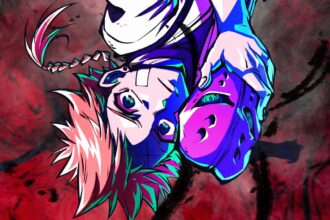Anime Herald: What is your origin story as an artist?
Daniel Liévano: After almost twenty-five years, I rewatched an anime series for the second time. Certain scenes left me reflecting deeply. Traditionally, people believe you choose your career when the time comes—usually after graduating from high school. But in reality, the unconscious has been quietly gathering experiences for years, making choices long before we think we’re “deciding.”
When I rewatched Saint Seiya in its Latin American version, all the knights in their pristine armor to save the Princess Saori, I realized how much beauty was there—the colors, the human forms, the shine of the armor. I guess this particular ecstasy of beauty never appeared to me all at once; it grew quietly, manifesting gradually over the years until I could finally recognize it. I suppose beauty in the form of colors and images really struck me from the early years, images are weird, they happen all the time.
(Editor’s note: I am always amazed at what a deep impact Saint Seiya had in Central and South America.)
Anime Herald: Who were the artists who inspired you?
Daniel Liévano: This time, I’ll give you a more honest answer, because I usually mention fine artists. Years ago, I actually wrote to Jan Feindt, Matthew Woodson, Señor Salme, and Wesley Allsbrook, asking them how they were able to create such jaw-dropping work.
At that time, I wasn’t an illustrator yet—I was around twenty and working only as a graphic designer. Their responses were so open and generous that they immediately pushed me toward illustration. I thought, “how is it possible that my idols would reply so frankly to my emails?” I like that about illustrators, we’re not divas, at least not all, we are a humble niche of people doing what we like.


Anime Herald: You’ve worked with The Folio Society on the works of Haruki Murakami before. What was your initial reaction when they first reached out to you?
Daniel Liévano: Folio is a cornerstone name in the illustration world. My reaction was the “expected” awe—like unlocking a new level in my career. It was the chance to experiment with texts by authors of experimental renown.
Anime Herald: Any fun stories from working on 1Q84?
Daniel Liévano: Not exactly “fun,” but certainly eye-opening—sometimes even frightening. 1Q84, much like Kafka on the Shore, convinced me that science fiction is not entirely fiction. Other worlds exist within us, and we, as such a young species, don’t yet have the codes or languages to interact with them. We only experience brief glimpses, fleeting moments of contact with these inner worlds.
Anime Herald: To illustrate Murakami’s works, you have to go beyond the text. You have to capture the vibes. How does abstraction help you accomplish that?
Daniel Liévano: I have a theory—probably not mine alone—that abstraction comes both first and last. Abstraction leads to concretion, because we need something tangible in order to grasp that initial impression. But once we’ve understood it—once we’ve felt it—a new abstraction arises.
A good metaphor is feelings: they exist in the body, which is the formal part of life, yet feelings remain abstract and largely wordless. So you live with abstraction inside your body, which is entirely tangible. A curious paradox. Murakami’s books live in that tension, and illustration has to honor that space.


Anime Herald: I love your advice to people: “Always take a walk.” Were walks something you appreciated as a child, or did that come later in adulthood?
Daniel Liévano: I think walking is one of humanity’s oldest devices for connecting to the world—even older than cooking, fire, or speech. Walking for the sake of walking is the essence of discovery and astonishment.
Anime Herald: Do you watch anime or read manga? If so, what are some of your favorites?
Daniel Liévano: Wow—I wasn’t expecting this question. And I already answered it in the very first question. What a coincidence.
Anime Herald: What advice would you give to aspiring artists?
Daniel Liévano: You are not just a draftsman—you are a thinker. Drawing is the projection of thought, even before writing. If you are good, your clients won’t just want your drawing skills—they’ll want your ideas.
Anime Herald: Now that you’ve worked on five Murakami books, which was your favorite?
Daniel Liévano: The first one: Kafka on the Shore.
Anime Herald: What is one thing you would like our readers to know about Bogotá or Colombia?
Daniel Liévano: Colombia is the “Goldilocks” of life. We understand the beauty of a morning meal, there are even poets giving praise to their ajiaco lunch. We live between leisure and hard work, leisure being both our present and our desire. We also know what progress looks like, and what cruel war feels like. The everyday Colombian is the archetype of someone who knows—yet doesn’t know they know.








